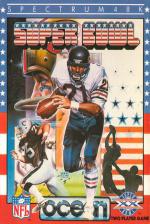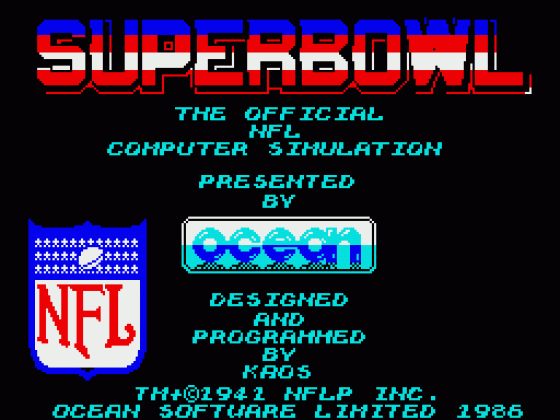
Computer Gamer
 1st May 1986
1st May 1986
Categories: Review: Software
Publisher: Ocean
Machine: Spectrum 48K
Published in Computer Gamer #14
Replay the game between the Chicago Bears and New England Patriots in Ocean's American Football simulation.
Super Bowl
The interest in football, American-style, has grown dramatically in the last few years. Now, courtesy of Ocean, you can sample the joys of the grid-iron without the padding.
The game is supplied in a twin cassette pack and contains a program tape that explains the basic rules of football so that you have at least some idea what you're trying to do when you play the game.
The game is a simulation of the Super Bowl played in January when the Chicago Bears destroyed the New England Patriots by the record score of 40-10. If you think you could do better than that then this is the game for you.
American Football
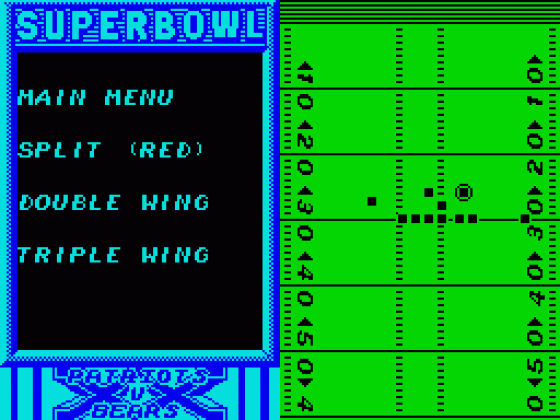
Before you can understand the game itself you will need to know the basic rules of American Football. These are explained in some detail on the game's accompanying audio cassette but here are the basics. Dedicated grid-iron fans should skip this next section.
US Football is played on a pitch 100 yards long which is marked off in ten yard marks. At either end on the pitch are the endzones. The object of the game is to move the ball into the opponent's endzone to score a touchdown (which is worth six points).
There are eleven players from each side on the field at any one time although in the real game there are about 45 split into three units. The offensive unit (attack), defensive unit and special teams that are brought on to kick the ball either as far down the pitch as possible (punt) or attempt a kick between the goal posts to score a field goal which is worth three points. After a touchdown the scoring team is allowed to try for an extra one point by kicking the ball through the goal posts from short range.

The offence moves the ball down field in a series of plays or set moves that might involve giving the ball to a runner such as Walter Payton or throw a short pass for more yards if it works. The yardage gained is important as the offence has four attempts, or downs, to gain a minimum of ten yards. If they succeed they start another set of downs, with another ten yards to make; if they fail the opposition get the ball.
The defence's job is simple - to stop them in their tracks so that they either don't make the yardage or force them to punt.
Finally, the game is played over four fifteen minute quarters with a kick-off beginning each half.
Gameplay

Super Bowl is a joystick-controlled game for either one or two players who take it in turns to decide their strategy for the forthcoming play.
The team on offence first decides the type of attack to use, run, short or long pass or kick and then selects his choice from the games menus. Each choice then leads to other submenus that are used to decide formations and elect pass receivers.
Then the defence chooses one of four basic defence formations and then can set up his men to mar specific players as well as selecting one to be controlled directly by the joystick.

Using this option, the defence can decide to mark on a man to man basis or go for something more subtle such as pile everyone onto the quarterback or whoever happens to have the ball.
Once both sides are ready, the play begins. On the press of the fire button, the ball is snapped back to the quarterback who will either run the ball or attempt to pass it to a receiver while the defence try to clobber him.
Once the play has come to a crunching end, both players must choose their next moves.
The Plays

The choice of plays is of course crucial in playing Super Bowl and so you should practise the available options and formations. For example, there are three different running play formations but, since you control the runner yourself the possibilities are incredible. Most will end in very little but some may break big for a touchdown.
As soon as the quarterback drops back to throw a pass the possibilities multiply considerably. Not only are there three different formations for both long and short passes there are five different eligible receivers. Although one is selected as part of the play the quarterback can (if he's quick enough) change to one of the others if his first choice is marked. Finally, he can also use the pass formation as a dummy and run the ball instead.
As you can see, the defence has a difficult job to not only work out exactly what the offence is up to but also how to stop them.
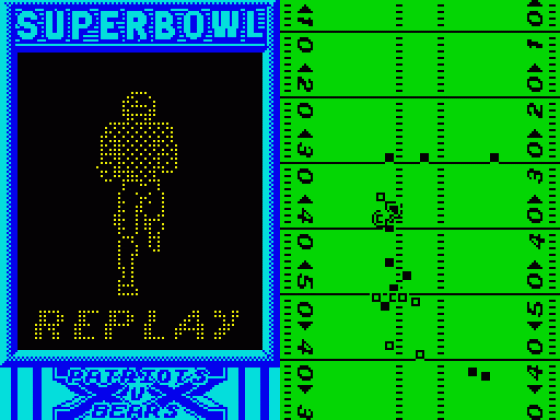
The defence has four basic formations to choose from ranging from a 7-1-3 formation used to pile everyone against the quarterback to either smother a pass or stop a run to a defensive 4-2-5 used to mark pass receivers.
It is important to remember that these formations are only a base to work from as you can also assign each player to mark specific offensive lineman of even the ball carrier.
The key to the defence lies with the joystick-controlled player as only he can react if you find you've got the defence totally wrong. As with the offensive pass receivers, you can swap the player you control but be quick or you may end up as a spectator. You should practice using this as he's your best chance to intercept a pass by which you can turn defence into attack.

Finally, the kicking team add their own brand of tactics for you to think about. Not only when to kick but also how much power to put into it. This is important as it also controls the accuracy of the kick during field goal and extra point attempts.
The kickoff is also a time when you may consider a gamble as a short kick results in a scramble for the ball which you might win and therefore regain possession. However, you may lose it and give your opponent about fifty free yards.
Graphics
The Super Bowl screen display is split into two vertical halves with the right hand side containing a scrolling plan view of the pitch. Here the players are represented as blue or white dots with the joystick-controlled players highlighted as squares.

This is a functional display on which the plays develop as you steer your players around the field. Graphics groupies should concentrate on the other side.
Underneath the Super Bowl banner and scoreboard is an area which doubles as the play menu area as well as a graphics screen.
Before a play the players move a hand icon through the game's menus to choose their offence or defence. Then during the play the display is replaced by two TV screens which key in on the main players and follow their moves (running, throwing, catching, etc). Unfortunately, you'll be too busy to watch this but don't worry as you can sit back and watch a replay on a giant TV screen when the play is over.
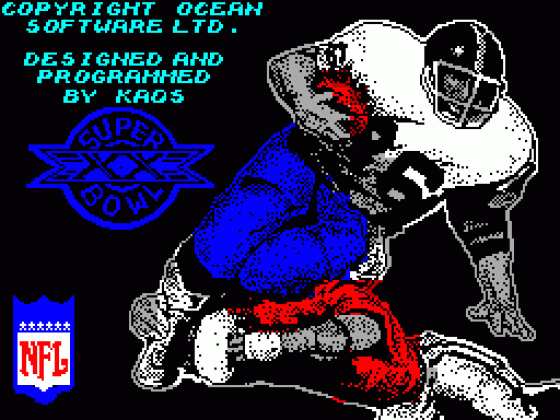
Finally included on the twin TV screen is a power gauge for kicking, the time left in the quarter and the yards to go. This vital information is also shown in the replay screen in the form of total yards gained or lost so far. Such as six yards gained - second down. Should you then lose a yard in your next play this would change to five yards gained - third down.
Conclusions
Super Bowl is Ocean's American Football game which promised much as it has been endorsed by the NFL.
Unfortunately early copies sent to us contained bugs that made the game almost unplayable (despite this, another magazine gave this version a rave review!).
Happily the bugs have been corrected now, and Super Bowl has passed its fitness test.
The game attempts to be a challenging game to both beginners and Football addicts by including in the package a tape introduction to the rules of Football as well as a one and two player game.
Although the one player game is weak, particularly against the run attack, it forms a useful base on which to build your tactics. Once you can beat it consistently you're ready for human opposition.
Then you won't be able to rely on learning predictable computer moves, instead you'll have to tune your strategy senses and flex your joystick fingers.
This is where the game comes into its element with the only problem being how to stop your opponent from watching you enter your play selections.
The result is a fascinating mix or arcade and strategy which simulates this amazing sport.
Super Bowl is available for Spectrum and C64 computers for £9.95 with an Amstrad conversion coming soon.
Other Reviews Of Super Bowl For The Spectrum 48K
Superbowl (Ocean)
A review by (Crash)
Super Bowl (Ocean)
A review by Max Phillips (Your Sinclair)
Superbowl (Ocean)
Time to don your shoulder pads and helmet as Ocean get on the grid iron with a simulation of American football
Superbowl (Ocean)
A review

